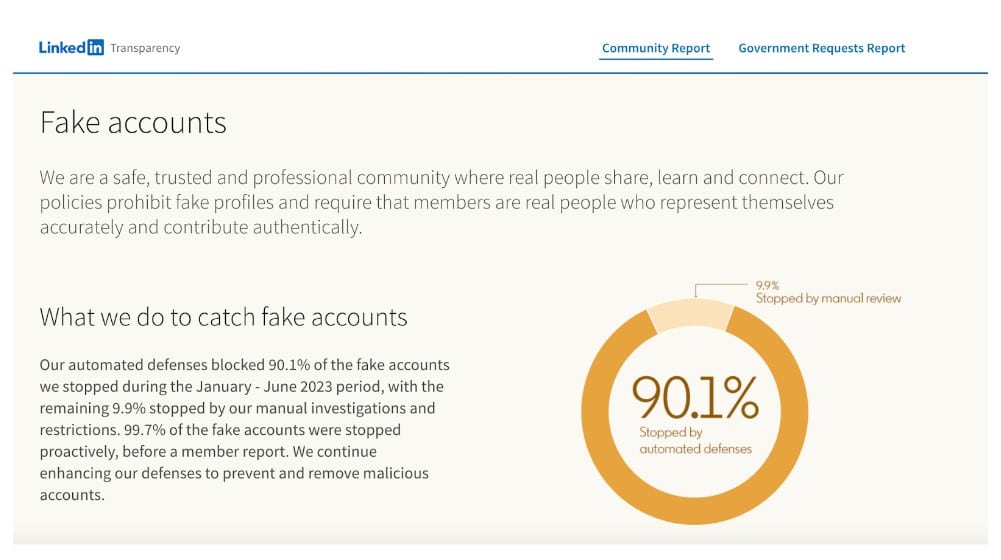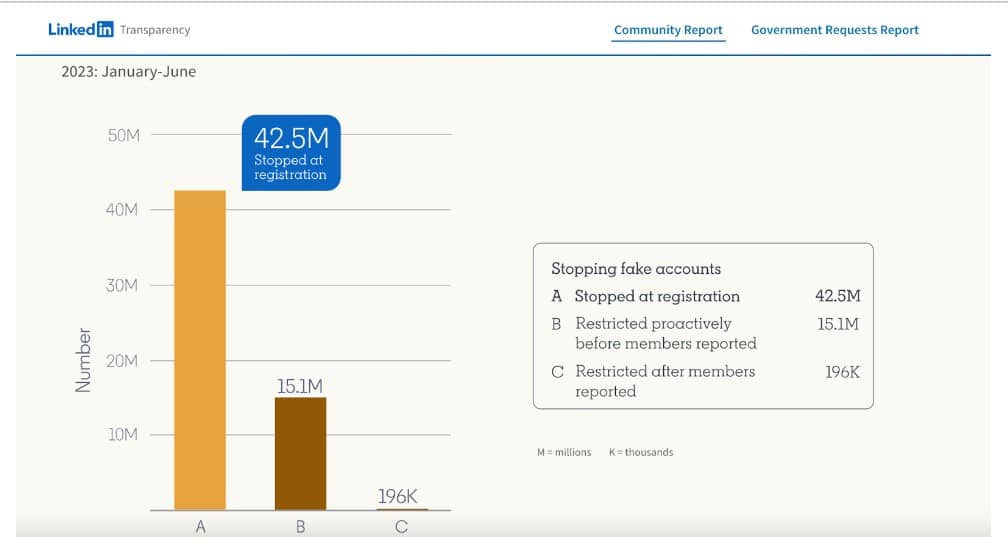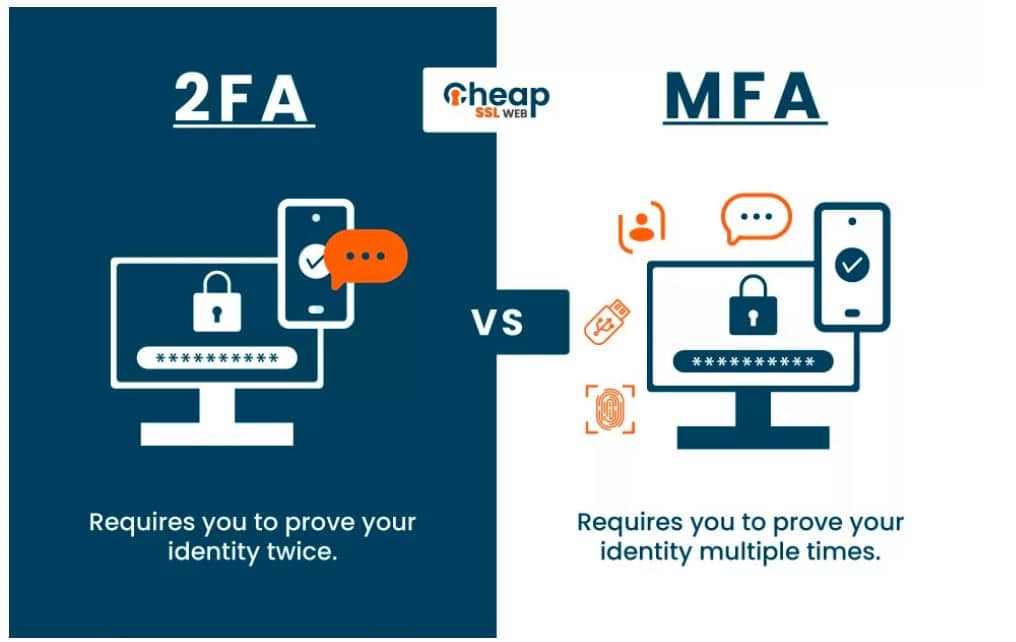Prioritizing online safety and social media security has become imperative for businesses of all sizes in the 21st century. As the number of social media platforms grows and cyber threats advance, safeguarding sensitive information and maintaining a secure online presence are essential for the success and reputation of any business.
The importance of online safety and social media security for businesses
Since most business strategies are driven by online connectivity and engagement, the significance of online safety cannot be overstated. Businesses rely on social media platforms not only to connect with customers but also to promote their brand, share updates, and engage in meaningful conversations with their target audience. Yet, even though social media offers convenience and opportunities, it also comes with risks. For example, LinkedIn, a big platform for professional networking, blocked over 21.9 million fake accounts in just six months, according to their transparency report. This shows how widespread online threats are and why strong security measures are essential.


Source: transparency-community-report
Understanding the risks and consequences of cyber threats
Cyber threats come in various forms, ranging from phishing attacks and malware infections to data breaches and identity theft. Some of the most common Social Media Security Risks may include:
- Phishing attacks and scams: Phishing scams are prevalent in the social media landscape. Scammers aim to trick users into revealing sensitive information like passwords or banking details. For instance, fake coupons for popular brands (e.g., Costco, Starbucks) circulate on platforms like Facebook. To claim the coupon, users unwittingly provide personal information.
- Imposter accounts: Imposters can easily create social media accounts that resemble a company’s official profile. Verification on social networks helps combat this. LinkedIn, for instance, blocked 95.3 percent of fake accounts automatically at registration, and then over 190,000 were addressed only after user reports.
- Malware attacks and hacks: Cybercriminals exploit social media channels to spread malware, steal data, and compromise accounts.
- Password theft: Weak passwords or password reuse across platforms can lead to security breaches.
- Vulnerable third-party apps: Integrating third-party apps with social accounts can expose businesses to risks. These apps may have security flaws or access more data than necessary. In fact, in a 2021 survey of 250 IT security professionals, 91 percent of respondents reported experiencing a security incident in the past 12 months that was linked back to a third party.
Understanding social media security involves being aware of the various ways individuals can be targeted online. These include tactics such as deceptive offers, fake profiles, and malicious software designed to compromise sensitive information.
Along with that, businesses must prioritize measures to combat debit card fraud, where unauthorized individuals gain access to financial accounts and exploit them. Implementing strong debit card fraud protection mechanisms, including advanced detection algorithms and encryption technologies, is crucial for preventing financial losses and maintaining customer trust.
Creating a secure environment
To mitigate the risks associated with social media usage, businesses must adopt a proactive approach to security. This means implementing robust security protocols and adopting best practices aimed at strengthening their online presence. One of the key measures may include:
- Implementing strong password policies: Enforcing complex password requirements and regular password updates can significantly reduce the risk of unauthorized access to accounts. These should include a mix of uppercase and lowercase letters, numbers, and special characters.
- Integrating multi-factor authentication (MFA) and two-factor authentication (2FA): Ensure that MFA and 2FA are implemented across applicable systems. This enhanced security measure adds a layer of defense by necessitating users to furnish a second form of verification, such as a text message or authentication app, alongside their password.
- Regularly updating security settings and software: Keeping social media platforms and associated software up to date with the latest security patches helps address known vulnerabilities and strengthens overall defense mechanisms.

Source: Cheapsslweb
Educating employees
It’s not just about tools, though. Businesses need to teach our team to be extra careful online. They should know how to spot tricks, scams, and suspicious emails and follow the rules when using social media for work. There are two steps businesses can take to educate their employees:
- Providing training on identifying phishing attempts and scams: To enhance employee awareness of phishing threats, implement regular training sessions covering common techniques like suspicious emails and fake websites to prevent all types of identity theft and cyber threats. Train them to recognize red flags, such as unexpected requests for sensitive information or misspelled URLs. Encourage employees to use a phishing link checker when in doubt about an email’s legitimacy. Additionally, conduct simulated phishing tests periodically to gauge their awareness and responsiveness levels.
- Establishing guidelines for sharing company information on social media: Social media platforms offer valuable opportunities for businesses to engage with customers and promote their brands. However, employees need to understand the importance of discretion when sharing company-related information online. Establishing clear guidelines regarding what can and cannot be shared on social media helps mitigate the risk of inadvertently disclosing sensitive or confidential information. Employees should be reminded to only share proprietary information, customer data, or internal communications with proper authorization.
Monitoring and managing online presence
After all this, it’s important to get to the next step, which is to monitor online presence and manage it accordingly. This is a step that is very often overlooked but is incredibly helpful in preventing potential cyber threats from emerging. Here’s how you can effectively monitor and manage your online presence:
- Utilizing social media monitoring tools: Invest in monitoring tools that track mentions, engagement, and any unusual activities across your digital platforms in real-time. These tools help you stay informed and promptly address any emerging issues, maintaining a positive online reputation.
- Establishing a response plan for security incidents: Develop a comprehensive response plan outlining clear steps to take in the event of a security incident or reputational crisis. Form a team responsible for handling security incidents related to social media. Predefined protocols enable you to mitigate the impact of threats and quickly restore trust and confidence among your audience.
- Conducting regular audits of social media accounts and data: Regular audits of social media accounts and data are essential practices for maintaining online security and compliance. It’s important to keep an up-to-date inventory of all official social media accounts linked to your business. Regularly reviewing access permissions is crucial, promptly removing access for former employees. Assessing the data shared on social media ensures compliance with privacy regulations such as GDPR and CCPA. Audit past posts, comments, and interactions to remove any outdated or inappropriate content, thus ensuring a clean and compliant online presence.
Partnerships and external resources
Once all the steps are completed to maintain the culture of online safety within your business, it’s important to consider engaging with external parties for future collaboration. This way, you can adapt your security strategy accordingly and ensure that your business remains protected against evolving cyber threats. This is how you can achieve that:
- Working with cybersecurity experts and consultants: This step can provide invaluable insights into emerging threats and best practices for enhancing your organization’s security posture. By leveraging their expertise, you can develop customized security solutions tailored to your specific needs and mitigate potential risks effectively.
- Collaborating with social media platforms for additional security measures: This allows you to access additional security features and tools designed to protect your accounts and data. By actively engaging with platform representatives, you can stay informed about new security enhancements, receive timely alerts about potential threats, and implement proactive measures to safeguard your online presence.
- Engaging in contract data security: This involves establishing clear and legally binding agreements with third-party vendors and partners who will access or process your business’s social media data.
- Staying informed about the latest trends and developments in social media security: Regularly monitoring industry news, attending relevant conferences and webinars, and participating in online forums enable you to stay informed about emerging threats, new security technologies, and best practices for mitigating risks. By staying ahead of the curve, you can adapt your security strategy accordingly and better protect your organization against evolving cyber threats.
Conclusion
Establishing a culture of online safety within businesses is not just a recommendation but a necessity in today’s interconnected digital world. Businesses can effectively protect their reputation and sensitive information from cyber threats by prioritizing security measures, educating employees, and actively monitoring their online presence. Moreover, fostering partnerships with cybersecurity experts and staying informed about the latest security trends ensures that businesses remain proactive in addressing potential risks. As technology continues to evolve, maintaining a commitment to online safety remains fundamental to ensuring the resilience and success of businesses.








